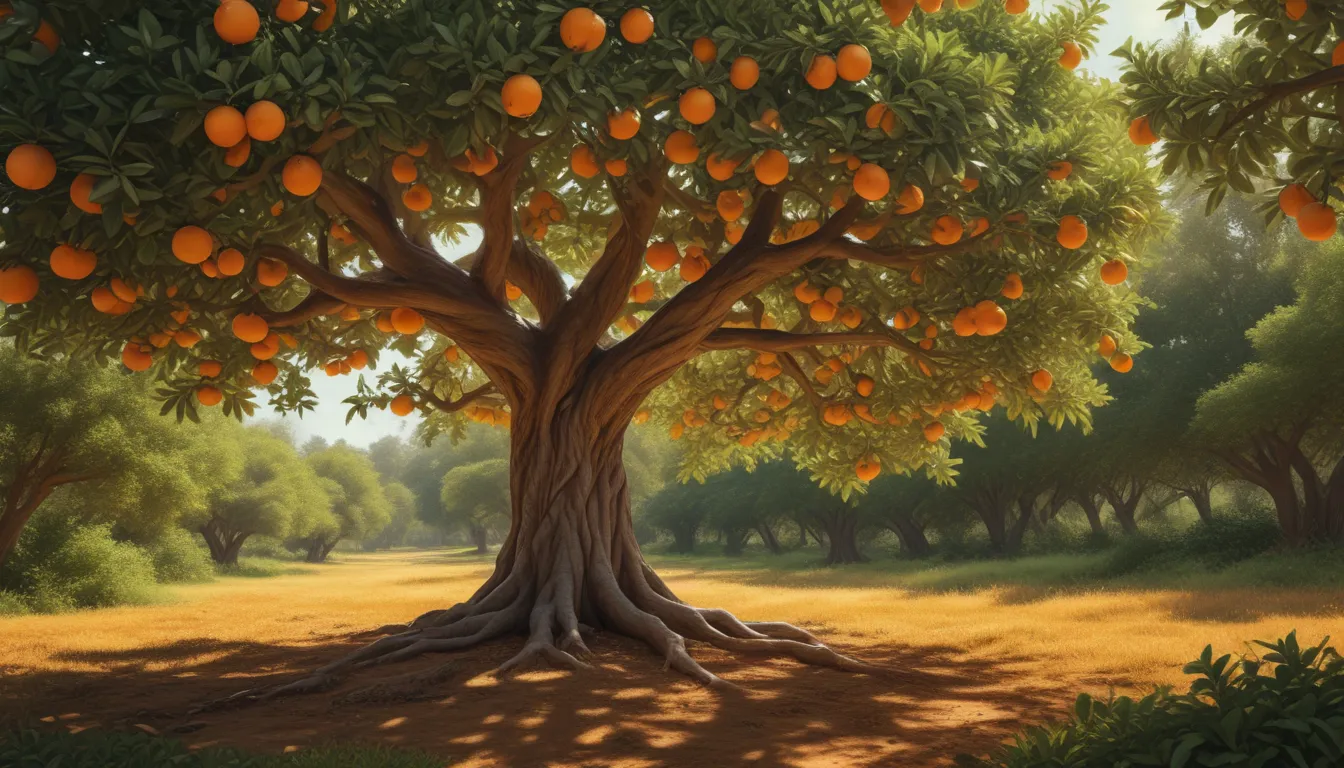The pictures we use in our articles might not show exactly what the words say. We choose these pictures to make you interested in reading more. The pictures work together with the words but don’t take their place. The words still tell you the important facts.
In the realm of horticulture, orange trees stand as a testament to abundance, vitality, and cultural significance. These evergreen treasures, originating from Southeast Asia, have a rich history woven into the tapestry of human culture and agriculture. As we embark on a journey through the groves of knowledge, let us uncover 20 captivating facts about orange trees, exploring their botanical wonders, cultural impact, and the intriguing stories that surround them.
Unveiling the Beauty of Orange Trees
Orange trees, scientifically known as Citrus sinensis, are evergreen trees that belong to the Rutaceae family. Their lush foliage and vibrant fruits have made them a staple in gardens and orchards worldwide. These trees symbolize abundance and vitality, requiring sunlight, well-drained soil, and regular pruning to thrive and produce high-quality fruit.
The Surprising Classification of Oranges
Contrary to popular belief, oranges are classified as a type of berry known as a hesperidium. This unique classification distinguishes oranges by their tough, leathery rind that encases the juicy pulp and seeds of the fruit.
A Journey Through Time: Orange Trees’ Ancient Origins
The journey of orange trees traces back to ancient China and India, where they were first cultivated. From their origins in Southeast Asia, orange trees spread across the globe to regions such as the Mediterranean and the Americas, leaving a trail of citrus abundance in their wake.
Battling Citrus Pests: A Thorn in the Side of Orange Trees
Despite their resilience, orange trees face threats from various pests such as aphids, mites, and citrus leaf miners. These pests pose a challenge to the health of the trees and the quality of the fruit they bear.
The Power of Vitamin C in Oranges
Oranges are renowned for their high vitamin C content, essential for boosting the immune system and promoting overall well-being. A single orange provides a significant portion of the recommended daily intake of this vital nutrient.
Embracing the Sun: Sunlight and Orange Trees
To flourish and bear fruit, orange trees require abundant sunlight. Planting them in locations that receive full sun for most of the day ensures optimal growth and productivity.
Culinary Delights with Oranges
The versatility of oranges extends to a wide range of culinary applications. From freshly squeezed orange juice to zesty orange marmalade, these fruits add a burst of flavor to both sweet and savory dishes.
Fragrance of Orange Blossoms
The sweet, citrusy fragrance of orange blossoms holds a special place in the perfume industry. This refreshing scent is often associated with freshness, vitality, and the essence of orange trees.
Symbolism of Abundance in Orange Trees
In many cultures, orange trees symbolize abundance, prosperity, and good fortune, making them a common sight during celebratory occasions where they represent themes of wealth and positivity.
Nurturing Orange Trees with Well-Drained Soil
Orange trees thrive in well-drained, slightly acidic soil that is crucial for their healthy growth and the quality of the fruit they produce. Proper soil conditions are key to supporting the vitality of these trees.
Diverse Settings for Orange Tree Cultivation
From expansive commercial orchards to cozy backyard gardens, orange trees adapt well to various cultivation environments. Their adaptability makes them suitable for both large-scale agricultural production and personal enjoyment.
Exploring the Rich Variety of Oranges
The world of oranges boasts a diverse range of varieties, each offering a unique flavor profile and characteristics. Popular varieties such as Valencia, Navel, Blood, and Seville oranges add depth and richness to the citrus landscape.
Pruning: A Vital Practice for Orange Trees
Regular pruning is essential for maintaining the health and productivity of orange trees. By shaping the trees, promoting fruit production, and removing damaged or diseased branches, pruning enhances the overall well-being of the trees.
The Economic Significance of Oranges
Oranges play a pivotal role in citrus economies, contributing significantly to the agricultural and economic landscape of many regions. Apart from fresh consumption, oranges are processed into juices and preserves, supporting a wide array of industries.
Frost Sensitivity: A Challenge for Orange Trees
While thriving in warm climates, orange trees are vulnerable to frost, which can damage the trees and impact the quality of the fruit. Protecting them from sudden drops in temperature is crucial for their well-being.
Brightness and Positivity: The Essence of Oranges
The vibrant color and refreshing flavor of oranges symbolize themes of sunshine, vitality, and positivity. They embody the spirit of brightness and energy, uplifting the senses and inspiring joy.
Natural Defense: Thorny Branches of Orange Trees
Many varieties of orange trees feature thorny branches that serve as a natural defense mechanism against browsing animals and pests. These thorns protect the trees and ensure their growth and development.
Cultural Legacy of Oranges
Oranges have left an indelible mark on human culture, appearing in folklore, art, and literature for centuries. They are linked to themes of abundance, fertility, and good fortune, enriching the cultural tapestry of civilizations around the world.
Propagation of Orange Trees: Through Grafting
The propagation of orange trees often involves grafting, a horticultural technique that joins a shoot or bud from a desired variety onto a compatible rootstock. This method ensures the cultivation of specific orange tree varieties with desirable characteristics.
Generosity and Goodwill: Symbolism of Gifting Oranges
In some traditions, the act of gifting oranges symbolizes generosity and goodwill. Exchanged during festive occasions, oranges serve as tokens of appreciation and well-wishing, fostering positivity and connection.
As we navigate the vibrant world of orange trees, we uncover a tapestry of botanical wonders, cultural significance, and economic importance. From their humble origins in Southeast Asia to their global cultivation, these evergreen treasures epitomize the essence of abundance, vitality, and generosity. Whether adorning vast orchards or intimate gardens, orange trees continue to captivate and inspire, embodying the timeless spirit of sunshine, vitality, and goodwill.
Conclusion
Orange trees stand as timeless symbols of nature's bounty, cultural richness, and economic vitality. Their fascinating history, diverse varieties, and essential role in human life make them a subject of endless fascination and admiration. As we celebrate the beauty and significance of orange trees, let us remember the value they bring to our lives and the world around us, nurturing an appreciation for these remarkable gifts of nature.
FAQs
Are orange trees easy to grow?
Orange trees thrive in warm climates with well-draining soil and ample sunlight. With proper care and attention to watering and fertilization, they can be relatively easy to grow in suitable environments.
How long does it take for an orange tree to bear fruit?
Typically, it takes around three to four years for an orange tree to produce its first fruit after being planted. Factors such as the tree's age, variety, and growing conditions can influence the exact timing of fruit production.
Unraveling the mysteries of orange trees unveils a world of botanical wonders, cultural connections, and economic significance. With each fact we discover, we deepen our appreciation for these vibrant trees that have carved a place in the hearts of people across the globe. Let us continue to nurture and celebrate the enduring beauty and vitality of orange trees, embracing their timeless legacy with joy and gratitude.






